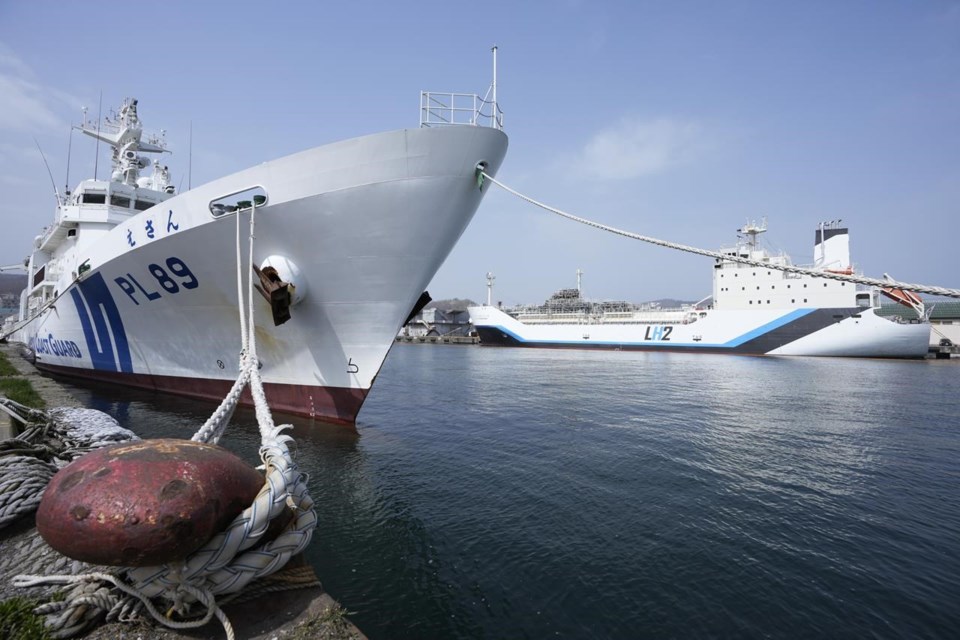OTARU, Japan (AP) — Wealthy nations can lead by example in cutting carbon emissions, though much faster action is needed to stem global warming, U.S. Energy Secretary Jennifer Granholm said Friday in an interview with The Associated Press.
Granholm and other senior energy and environment officials from the Group of Seven advanced economies are in Hokkaido in northern Japan this week for meetings on climate change, energy security and related issues.
“That’s what we hope to do is lead by example,” Granholm said after touring the world’s first and only liquefied hydrogen carrier, a ship that showcases Japanese efforts to transform heavily polluting coal into emissions-free hydrogen power.
At the G-7 summit in May last year, member nations set a common goal of achieving a fully or predominantly decarbonized electricity supply by 2035.
The fact that carbon emissions are continuing to rise despite massive investments in cleaner energy is “very disappointing,” Granholm said. But she noted that 90% of the new generating capacity that came online globally last year is from renewable sources.
“So this is happening. The tectonic plates are shifting, and it has to happen more quickly,” she said, pointing to U.S. efforts to curb emissions in transportation and power generation and other steps toward “decarbonization” of many industries.
Still, the approval of major fossil fuel projects such as the Willow project on Alaska’s petroleum-rich North Slope has drawn criticism that it runs counter to President Joe Biden’s pledges to cut carbon emissions and move to clean energy. There are also objections to the project's environmental impact.
Environmentalists say Japan's strategy of relying on fossil fuels such as coal, even with technologies like carbon capture that prevent emissions from escaping into the atmosphere, and failure to more fully embrace renewable energy sources such as wind and solar power, fails to set a persuasive example for other major polluters such as China and India.
Granholm said that moves toward embracing renewable, clean energy sources, including hydrogen, nonetheless “give hope to others to be able to do it as the technology lowers the cost."
The Suiso Frontier, the ship Granholm toured Friday as it was docked in the port of Otaru, is the world's only liquefied hydrogen marine carrier. Built by Japanese ship maker Kawasaki Heavy Industries, it carries hydrogen cooled to minus 253 degrees Celsius (minus 423 degrees Fahrenheit) in a liquid form that occupies one eight hundredth of the volume it would occupy as a gas.
The 8,000-ton ship was built to carry hydrogen produced at a coal gasification facility in Australia to Japan for power generation and to fuel vehicles, among other uses.
The Biden administration is turning to hydrogen as an energy source for vehicles, manufacturing and generating electricity. It’s offering $8 billion to entice the nation’s industries, engineers and planners to figure out how to produce and deliver clean hydrogen.
“We’re interested in taking this to the next level in making sure that it can be derived from clean sources,” Granholm said while standing on the bridge of the vessel, whose home port is Kobe.
American companies made final pitches earlier this month in bidding for a new program that will create regional networks, or “hubs,” of hydrogen producers, consumers and infrastructure. The aim is to accelerate the availability and use of the colorless, odorless gas that already powers some vehicles and trains.
The Department of Energy is required to fund at least four hydrogen hubs by 2026. The hubs are to demonstrate various ways of producing hydrogen, including fossil fuels, nuclear power and renewable energy sources.
The challenge is to ensure such projects are commercially feasible, that there is adequate demand from industries for the hydrogen.
The Department of Energy has estimated that at least $85 billion is needed to establish a U.S. hydrogen industry.
Despite ambitions to turn the country into a “hydrogen society,” Japan’s own hydrogen industry is in its infancy, with the government still drawing up the legislation needed to support creation of infrastructure and supply chains for commercial use of hydrogen and ammonia.
Part of that plan involves providing an estimated 7 trillion yen ($53 billion) in subsidies to help bridge the difference in prices between energy produced from hydrogen and conventional sources such as natural gas.
Since hydrogen is difficult to transport it is sometimes stored as liquid ammonia, which is one part nitrogen to three parts hydrogen. Ammonia allows the hydrogen to be stored and shipped more easily and compactly.
Supporters of hydrogen and ammonia say they offer a way for countries in Southeast Asia, whose combined emissions are the world’s fourth largest, to meet rising demand for power while cutting carbon emissions.
Another is nuclear power.
Granholm praised Japan's decision to restart many of the nuclear power plants it idled for safety concerns after a massive earthquake and catastrophic tsunami in March 2011 triggered meltdowns at the Fukushima Dai-Ichi nuclear plant on the northeastern coast of its main island.
It's a choice that many in the energy-scarce nation view as inevitable, even as the plants near the end of their expected lifetimes.
Major Japanese industries such as steelmakers, manufacturers and electrical utilities are heavily invested in fossil fuel-based technologies and have huge sway over the government and politicians, Kumiko Hirata, founder and international director of Climate Integrate (Japan), said in an online briefing.
Japan's “green transformation” strategy, which includes commercializing the use of hydrogen and ammonia, mainly caters to big business interests, she said.
“They always argue that using existing technology is the most economically feasible approach for decarbonization and because of that, climate policy development in Japan has been so slow,” she said. “And Japan became the laggard among the G-7.”
Elaine Kurtenbach, The Associated Press


